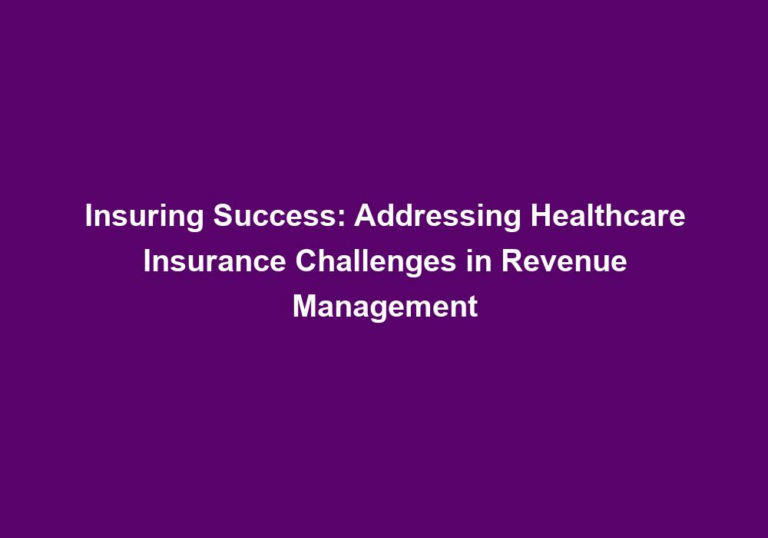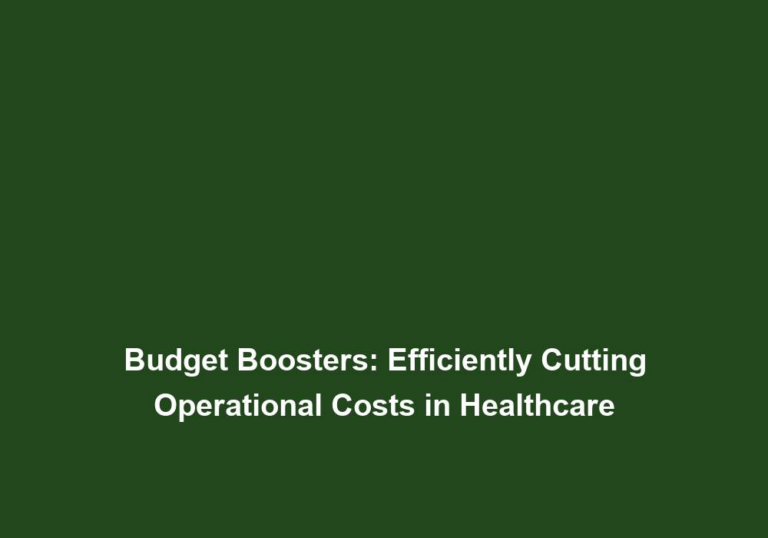Healthcare Economics: Efficient Financial Management for Clinics
In today’s healthcare landscape, efficient financial management is crucial for clinics to not only survive but thrive. With rising costs, changing reimbursement models, and increasing patient expectations, clinics need to adopt effective strategies that optimize their financial performance. This article explores key principles and practices of healthcare economics that can empower clinics to achieve efficient financial management.
1. Understanding the Healthcare Economic Landscape
Before delving into the strategies for efficient financial management, it is essential to comprehend the unique economic challenges that clinics face. By understanding these challenges, clinics can better navigate the complexities of the healthcare system and make informed decisions. Some key factors influencing the healthcare economic landscape include:
-
Reimbursement Models: Clinics need to navigate various reimbursement models, such as fee-for-service, bundled payments, and value-based care. Understanding the intricacies of these models is crucial for maximizing revenue. For example, clinics can implement strategies like proper coding and documentation to ensure accurate reimbursement.
-
Regulatory Environment: Compliance with healthcare regulations, such as the Affordable Care Act (ACA) and the Health Insurance Portability and Accountability Act (HIPAA), is vital to avoid penalties and legal issues that can drain financial resources. Clinics must stay updated on regulatory changes and ensure their operations align with the requirements.
-
Health Insurance: With an increasing number of patients relying on insurance coverage, clinics must effectively manage insurance claims, billing, and negotiations to ensure timely payments and minimize denials. This involves establishing efficient processes for claims submission, tracking, and follow-up, as well as staying informed about insurance policies and reimbursement rates.
2. Developing an Efficient Financial Management Plan
To achieve efficient financial management, clinics should design a comprehensive plan that encompasses various aspects of their operations. This plan serves as a roadmap for clinics to optimize their financial performance and adapt to the changing healthcare landscape. Here are key elements to consider:
a. Revenue Cycle Management
Efficient revenue cycle management is critical for clinics to optimize cash flow and minimize revenue leakage. It involves a series of steps that start from scheduling an appointment to receiving payment for services rendered. Key strategies to enhance revenue cycle management include:
-
Effective Coding and Documentation: Accurate coding and thorough documentation of patient encounters ensure proper reimbursement for services provided. This includes capturing all relevant diagnoses and procedures, as well as complying with coding guidelines and documentation requirements.
-
Streamlined Claims Management: Implementing technology-enabled systems for claims submission, tracking, and follow-up can enhance efficiency and reduce claim denials. Automation can help clinics identify and correct errors, track the status of claims, and streamline the overall claims management process.
-
Patient Financial Responsibility: Establishing clear processes for patient financial counseling, billing, and collections helps clinics recover patient payments promptly. This may involve providing patients with transparent information about their financial responsibilities, offering flexible payment options, and implementing effective collection strategies.
b. Cost Control and Financial Analysis
Controlling costs and regularly analyzing financial data are essential for clinics to make informed decisions and improve their financial performance. Consider the following:
-
Expense Monitoring: Regularly reviewing expenses, negotiating with vendors, and identifying cost-saving opportunities can contribute to financial stability. Clinics can explore options like group purchasing organizations (GPOs) to leverage collective buying power and reduce costs.
-
Budgeting and Forecasting: Developing comprehensive budgets and regularly analyzing financial forecasts enables clinics to plan effectively and adapt to changing economic conditions. This involves setting financial goals, monitoring performance against those goals, and making adjustments as necessary.
-
Key Performance Indicators (KPIs): Identifying and tracking KPIs, such as average revenue per visit, cost per patient, and profitability by service line, provides valuable insights for financial management. Clinics can use KPIs to measure their financial performance, identify areas for improvement, and benchmark against industry standards.
c. Contract Negotiation and Strategic Partnerships
Effective contract negotiation and strategic partnerships can help clinics optimize revenue and reduce costs. By collaborating with payers and other healthcare providers, clinics can establish mutually beneficial relationships that enhance financial performance. Consider these approaches:
-
Negotiating with Payers: Clinics should proactively negotiate contracts with insurance payers to ensure fair reimbursement rates and favorable terms. This may involve analyzing reimbursement rates, understanding payer policies, and advocating for appropriate compensation.
-
Collaborating with Ancillary Service Providers: Partnering with ancillary service providers, such as diagnostic laboratories or imaging centers, can enhance revenue generation while providing comprehensive care to patients. These partnerships can lead to cost savings, increased efficiency, and improved patient outcomes.
3. Embracing Technology Solutions
In the age of digital transformation, leveraging technology solutions is crucial for efficient financial management in clinics. Technology can automate processes, improve accuracy, and provide valuable insights. Here are some areas where technology can make a significant impact:
-
Electronic Health Records (EHR): Implementing EHR systems streamlines documentation, coding, and billing processes, reducing errors and improving efficiency. EHRs also enable better care coordination, facilitate communication among healthcare providers, and support data exchange with payers.
-
Practice Management Software: Integrated practice management software enables clinics to automate administrative tasks, appointment scheduling, and billing, freeing up staff time and reducing manual errors. This software can also generate financial reports, track patient encounters, and streamline revenue cycle processes.
-
Data Analytics: Utilizing advanced data analytics tools can help clinics identify trends, optimize resource allocation, and make data-driven decisions for financial management. These tools can analyze financial data, patient demographics, and clinical outcomes to uncover insights that drive financial performance improvement.
Conclusion
Efficient financial management is indispensable for clinics to thrive in the ever-evolving healthcare landscape. By understanding the healthcare economic landscape, developing a comprehensive financial management plan, and leveraging technology solutions, clinics can enhance revenue, control costs, and achieve long-term financial sustainability. Embracing these strategies will empower clinics to provide quality care while navigating the complex world of healthcare economics.







